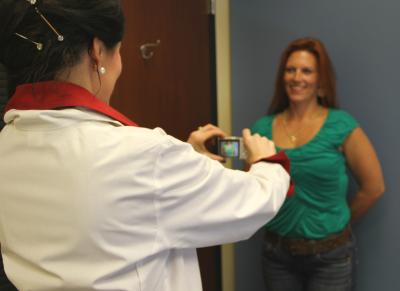

Kim Beckman, of Casstown, Ohio, recently lost 75 pounds and says she still didn't have the body she wanted. After consulting with her plastic surgeon, Beckman got a breast lift using the tissue she already had, then used implants to supplement what she didn't. According to the American Society of Plastic Surgeons, breast lifts are an increasingly popular option, particularly with women over 40, growing at twice the rate of implants since 2000.
Credit: American Society of Plastic Surgeons
New statistics released today by the American Society of Plastic Surgeons (ASPS) show that breast lift procedures are growing at twice the rate of breast implant surgeries. Since 2000, breast lifts have grown by 70 percent, outpacing implants two-to-one. Breast implants are still by far the most performed cosmetic surgery in women, but lifts are steadily gaining. In 2013, more than 90,000 breast lift procedures were performed by ASPS member surgeons.
“Many women are looking for a youthful breast by using the tissue they already have,” said ASPS President Robert X. Murphy, Jr., MD.
According to the new statistics, women between the ages of 30-54 made up nearly 70 percent of the breast lift procedures performed in 2013. “The breast lift procedure is way up in my practice,” said Anne Taylor, MD, an ASPS-member plastic surgeon in Columbus, Ohio. “More women are coming to us who've had children, whose breast volume has decreased and who are experiencing considerable sagging,” she said. “For many of them, we are able to get rid of excess skin and lift the breasts back up where they're supposed to be.”
Kim Beckman of Casstown, Ohio is one of the women who went to Dr. Taylor. “Childbirth, breastfeeding and aging takes a toll on the body,” she said. “I finally decided one morning that I was going to lose weight and get healthy.”
Beckman started eating right and exercising and, even though she lost more than 75 pounds, she still wasn't completely satisfied. “From the waist down, I was happy with what I saw. But from the waist up, I knew that there was still something I needed to do in the chest area.”
Like many women, Beckman had lost volume in her breasts over the years, and after losing weight, had considerable sagging. “In those situations, there's really no other way to get the breast lifted back up without the breast lift surgery,” said Dr. Taylor.
“The ideal candidate for a breast lift is a woman who has a good amount of breast tissue left, who doesn't necessarily want to have implants,” said Dr. Murphy. “Many women aren't sure if they are a candidate for this type of surgery, but a simple pencil test can tell them if they are,” he said.
To perform the pencil test, a woman simply places a pencil under her breast. “If the breast tissue holds the pencil in place against the chest, that implies that there's a hanging nature to the breast that can be fixed with a lift.” said Dr. Murphy.
Though she eventually opted for implants, too, the idea of starting with a surgery that only used her natural tissue appealed to Kim Beckman. “I'm a nurse myself,” said Beckman, “so I put a lot of consideration into anything medical, especially when it comes to surgical intervention.”
“Now that I've had the procedure, I feel confident. I'm wearing clothes that I never really thought that I would wear. I've worn a bikini on the beach and I'm comfortable. I didn't feel the need to cover up in a towel or throw on a t-shirt to walk down the beach with my husband. I feel good.” she said.
According to the latest statistics from ASPS, fewer than 53,000 breast lifts were performed in 2000. Last year there were 90,006, an increase of 70 percent since 2000, marking the first time that number has eclipsed 90,000.
Breast augmentation remains the most popular plastic surgery procedure for women. In 2013, there were 290,224 breast augmentation surgeries performed by ASPS member surgeons. That represents a growth of 37% since 2000, just under half the rate of breast lifts.
For more statistics on trends in plastic surgery including gender, age, regional, national average fees and other breakouts, refer to the ASPS 2013 National Clearinghouse of Plastic Surgery Procedural Statistics report at PlasticSurgery.org/Stats. Visitors can also find information about procedures and referrals to ASPS Member Surgeons at PlasticSurgery.org.
About ASPS
The American Society of Plastic Surgeons (ASPS) is the world's largest organization of board- certified plastic surgeons. Representing more than 7,000 Member Surgeons, the Society is recognized as a leading authority and information source on aesthetic and reconstructive plastic surgery. ASPS comprises more than 94 percent of all board-certified plastic surgeons in the United States. Founded in 1931, the Society represents physicians certified by The American Board of Plastic Surgery or The Royal College of Physicians and Surgeons of Canada. ASPS advances quality care to plastic surgery patients by encouraging high standards of training, ethics, physician practice and research in plastic surgery. You can learn more and visit the American Society of Plastic Surgeons at PlasticSurgery.org or Facebook.com/PlasticSurgeryASPS or Twitter.com/ASPS_News.
Broadcast quality multimedia elements at: bit.ly/1dEk67y (Multimedia Newsroom is password protected until embargo lifts. Please contact a media relations representative listed below for password prior to embargo.)
Media Contacts: Shannon McCormick, 614-477-2719 or 614-932-9950, shannon@mediasourcetv.com










